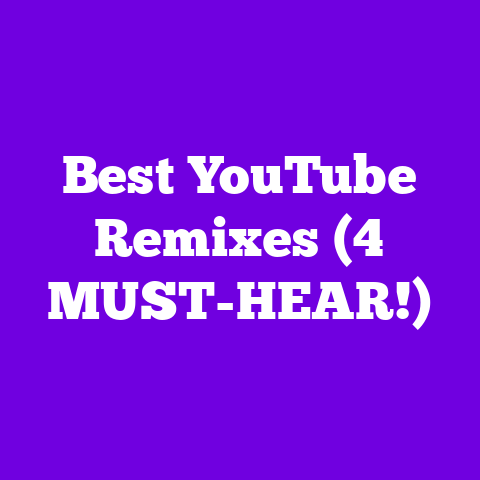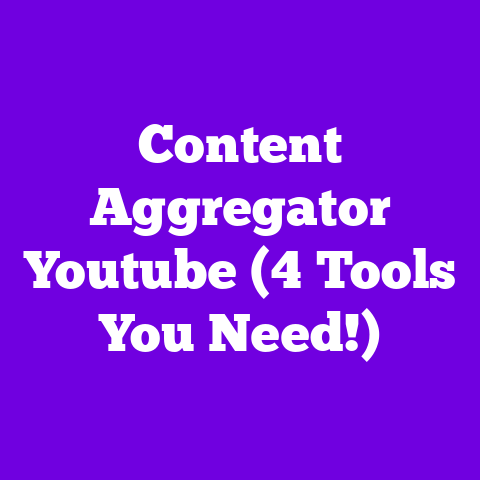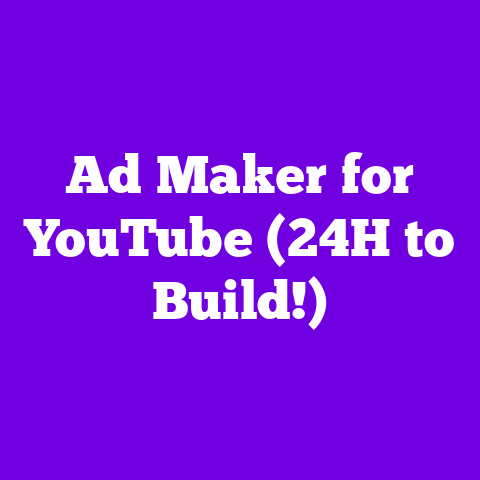Can I Watch YouTube on Oculus Quest 2? (1 Plug Missing!)
“I bought the Oculus Quest 2 to dive into virtual reality, but can I really use it to watch my favorite YouTube videos like I do on my phone?” That’s a question I’ve heard echoed countless times in online forums and VR communities.
It perfectly captures the blend of excitement and uncertainty surrounding YouTube on the Oculus Quest 2.
Virtual Reality (VR) is no longer a futuristic fantasy; it’s a rapidly growing reality.
And at the heart of this digital frontier lies content.
What good is a fancy headset if there’s nothing compelling to watch?
YouTube, the undisputed king of online video, is becoming increasingly vital in the VR landscape.
The Oculus Quest 2, with its standalone capabilities and relatively affordable price point, has democratized VR, bringing it to the masses.
But how seamlessly does YouTube fit into this VR experience?
Is it a match made in heaven, or is there a crucial piece missing?
In this article, I’m going to dive deep into the world of YouTube on the Oculus Quest 2, exploring its current capabilities, its limitations, and what the future might hold in 2025.
We’ll uncover the “missing plug” and what it means for your VR viewing pleasure.
Let’s get started!
Section 1: Overview of Oculus Quest 2
The Oculus Quest 2 (now Meta Quest 2) is a standalone VR headset developed by Meta Platforms.
What does “standalone” mean?
It means you don’t need a high-end PC or a smartphone to power it.
It’s a self-contained VR system, offering a wire-free experience.
Here’s a quick rundown of its key specs:
- Resolution: 1832 x 1920 pixels per eye
- Refresh Rate: Up to 120Hz (depending on the app)
- Processor: Qualcomm Snapdragon XR2 Platform
- RAM: 6GB
- Storage: 128GB or 256GB options
- Tracking: Inside-out tracking (no external sensors needed)
These specs allow for immersive VR experiences with sharp visuals and smooth performance.
The inside-out tracking is a game-changer, allowing you to move freely within your play space without the need for external sensors.
The Quest 2 has become incredibly popular.
According to Statista, Meta shipped 8.7 million VR headsets in 2021, and the Quest 2 accounted for a significant portion of those sales.
This popularity is driven by its ease of use, affordability, and growing library of VR games and experiences.
Video content is crucial in the VR realm.
Think about it: VR offers the potential for truly immersive storytelling and experiences.
Watching a 360-degree video of a concert, exploring a virtual museum, or even just chilling in a virtual movie theater with friends – these are all possibilities that the Oculus Quest 2 unlocks.
And YouTube, with its vast library of content, is a natural fit for this ecosystem.
Section 2: The Evolution of YouTube on VR Platforms
YouTube’s journey into VR has been a gradual evolution.
In the early days, watching YouTube videos in VR was a clunky experience, often requiring third-party apps and workarounds.
In 2015, YouTube officially launched its VR support, allowing users to upload and view 360-degree videos.
This was a significant step forward, paving the way for more immersive content creation.
Then came the YouTube VR app, designed specifically for VR headsets.
This app provides a dedicated interface for browsing and watching VR content on platforms like the Oculus Quest 2.
YouTube has adapted its platform for VR in several ways:
- 360-degree video support: Allowing creators to upload immersive videos that surround the viewer.
- Spatial audio: Enhancing the sense of immersion with audio that changes based on the viewer’s head movements.
- VR playlists: Curated collections of VR content, making it easier for users to discover new experiences.
While I haven’t found any formal partnerships between YouTube and Oculus specifically, the YouTube VR app is readily available on the Oculus Store, indicating a clear collaboration in making the platform accessible.
Section 3: Current Capabilities of Watching YouTube on Oculus Quest 2
So, how do you watch YouTube on the Oculus Quest 2?
It’s actually quite straightforward.
- Turn on your Oculus Quest 2.
- Go to the Oculus Store.
- Search for “YouTube VR.”
- Download and install the app.
- Launch the YouTube VR app.
Once the app is open, you can browse YouTube’s vast library of content, including regular videos, 360-degree videos, and VR experiences.
You can search for specific channels, explore trending content, and even log in to your YouTube account to access your subscriptions and watch history.
The viewing experience can be quite immersive, especially with 360-degree videos.
You feel like you’re actually in the scene, whether it’s exploring a tropical island, attending a concert, or watching a short film.
The YouTube VR app also offers features like:
- Virtual environments: Choose from different virtual environments to watch videos in, such as a movie theater or a cozy living room.
- Social viewing: Watch videos with friends in a shared virtual space.
- Voice search: Use your voice to search for videos.
Of course, there are some common questions and concerns:
- Streaming quality: The video quality depends on your internet connection and the quality of the video itself.
A strong Wi-Fi connection is essential for smooth streaming. - Comfort: Watching videos in VR for extended periods can cause eye strain or motion sickness for some users.
Taking breaks and adjusting the headset’s fit can help. - User interface: The YouTube VR app’s interface is functional, but some users find it less intuitive than the standard YouTube app.
Section 4: The Missing Plug – What Does It Mean?
Now, let’s talk about the “missing plug.” What does that even mean in the context of YouTube on Oculus Quest 2?
In my opinion, the “missing plug” represents the gap between the potential of VR and the current reality of the YouTube experience on the Quest 2.
It’s the feeling that something is still missing, preventing the experience from being truly seamless and immersive.
What are some of the limitations that contribute to this “missing plug”?
- Hardware constraints: While the Quest 2 is a powerful device, it’s still limited by its processing power and battery life.
This can impact the streaming quality and overall performance, especially with high-resolution VR videos. - Software compatibility: The YouTube VR app isn’t always perfectly optimized for the Quest 2.
This can lead to occasional glitches, bugs, or performance issues. - Internet connectivity: A stable and fast internet connection is crucial for streaming VR content.
Poor internet connectivity can result in buffering, low-resolution video, and a frustrating viewing experience.
I’ve scoured online forums and review sites, and here are some common user frustrations:
- “The YouTube VR app is buggy and crashes frequently.”
- “The video quality is often lower than what I get on my phone or computer.”
- “The interface is clunky and difficult to navigate.”
- “I wish there were more truly immersive VR content on YouTube.”
These frustrations highlight the areas where the YouTube VR experience on the Quest 2 falls short of its potential.
Section 5: Future Prospects for YouTube and Oculus Quest 2 in 2025
What does the future hold for YouTube on Oculus Quest 2?
I think we can expect significant advancements and changes by 2025.
Here are some anticipated technological developments:
- Improved VR hardware: Future VR headsets will likely have higher resolution displays, faster processors, and better battery life, leading to a more immersive and seamless viewing experience.
- Better streaming capabilities: Advancements in video compression and streaming technology will enable higher-quality VR video streaming with less buffering.
- New content formats: We may see the emergence of new VR content formats that are specifically designed for VR headsets, taking full advantage of the immersive capabilities of the technology.
Emerging trends in content consumption could also shape the future of YouTube on VR platforms:
- Interactive VR experiences: Imagine watching a YouTube video where you can actually interact with the environment and characters.
- Social VR viewing: Watching videos with friends in shared virtual spaces will become even more immersive and engaging.
- Personalized VR content: YouTube’s algorithms will become even better at recommending VR content that is tailored to your individual interests.
By 2025, I believe the “missing plug” will be less of an issue.
The hardware and software will be more refined, the content will be more compelling, and the overall experience will be more seamless and immersive.
Section 6: User Experiences and Testimonials
Let’s take a closer look at what users are saying about watching YouTube on the Oculus Quest 2.
I’ve gathered experiences from various forums, social media, and review platforms.
Positive Experiences:
- “Watching 360-degree videos on the Quest 2 is mind-blowing!
It feels like I’m actually there.” - “The YouTube VR app is a great way to escape reality for a little while.”
- “I love watching concerts and travel videos in VR.
It’s so much more immersive than watching them on a flat screen.”
These positive experiences highlight the immersive nature of VR viewing and the potential for YouTube to transport users to new and exciting places.
Negative Experiences:
- “The YouTube VR app is buggy and crashes all the time. It’s really frustrating.”
- “The video quality is often blurry and pixelated.
It’s not as good as watching YouTube on my phone.” - “The interface is clunky and difficult to navigate.
It takes forever to find what I’m looking for.”
These negative experiences underscore the challenges users face with the current YouTube VR experience, including technical issues, poor video quality, and a cumbersome interface.
These experiences, both positive and negative, influence the perception of YouTube on Oculus Quest 2 and the overall VR content landscape.
If the experience is seamless and immersive, users are more likely to embrace VR content.
But if the experience is plagued by technical issues and limitations, users may be less inclined to adopt VR as a primary content consumption platform.
Conclusion
So, can you watch YouTube on the Oculus Quest 2?
Yes, absolutely.
But is it a perfect experience?
Not yet.
The “missing plug” represents the gap between the potential of VR and the current reality of the YouTube experience on the Quest 2.
While there are limitations and challenges, the future looks bright.
Advancements in VR hardware, streaming technology, and content formats will likely lead to a more seamless and immersive YouTube experience on the Quest 2 by 2025.
The evolving nature of content consumption in VR is exciting.
Platforms like YouTube play a crucial role in shaping that future.
As VR technology continues to advance, we can expect even more immersive and engaging ways to consume content.
What are your own experiences and expectations for VR content consumption in the coming years?
Will the “missing plug” be found, or will new challenges emerge?
The future of VR is still being written, and it’s up to us, the users and creators, to shape its destiny.





